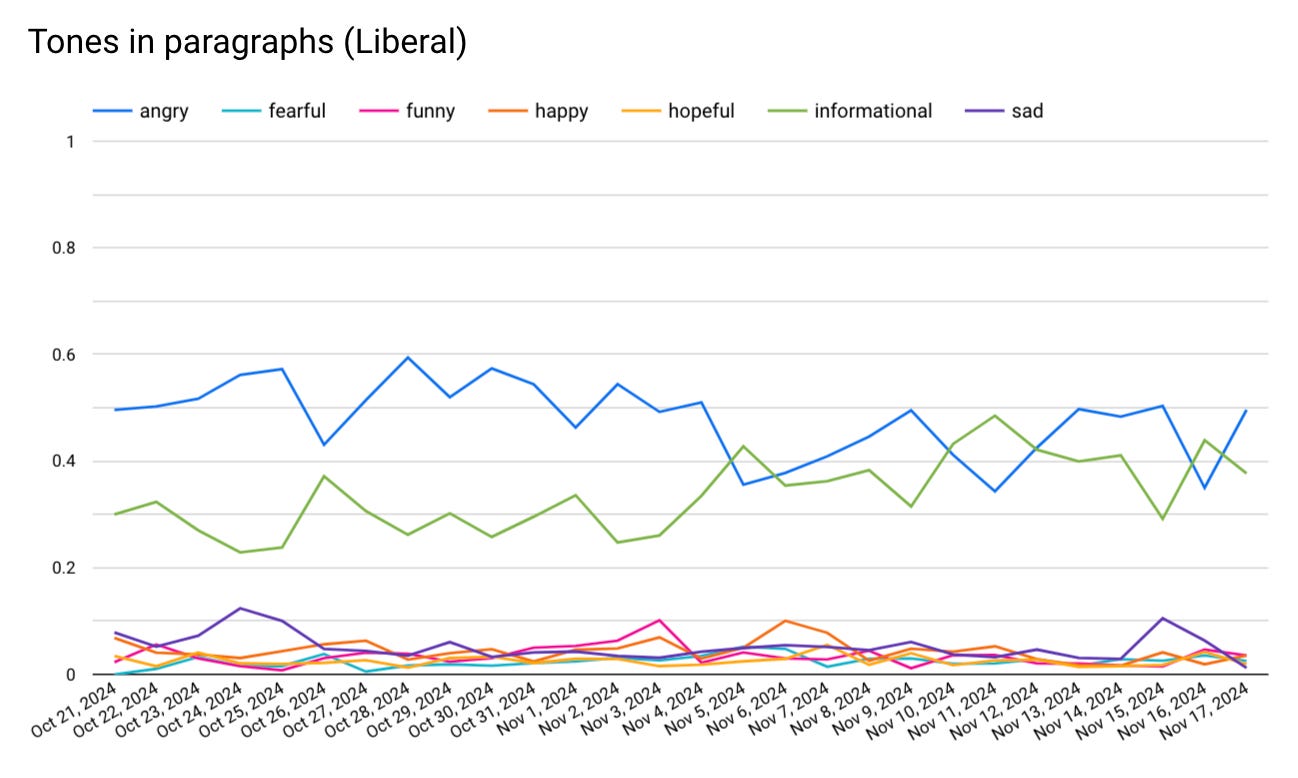What happened with US election "tones" + How to get people to agree with each other using AI
An interview with "Habermas Machine" creator Prof. Chris Summerfield
History may be written by the victors, but that doesn’t mean that there are no competing narratives.
Elections in 2024, from India to Europe to the U.S. have produced winners, though one of the repeated insights is how split different countries’ populations are.
This leads to larger questions about how to govern citizens that on the face of it doesn’t seem to agree on much, and the information environment that could make it easier to have civil discourse about the challenges in public life.
Earlier this month Overtone’s Chief Product Officer sat down with Prof. Chris Summerfield of Oxford to chat about his work on the “Habermas machine” that uses AI to help people, many with conflicting views, to find agreement.
Below you can find updates on the “tones” around the U.S. election as well as updates from Overtone.
SWING STATE OUTLETS SHOW DIFFERENT “TONE” TO NATIONAL DISCOURSE
Our last newsletter looked at a tumultuous period in the U.S. election, from a poor debate performance by President Joe Biden to the attempted assassination of former President Donald Trump and Biden’s replacement as nominee by Vice President Kamala Harris.
Since then, Trump won all of the major swing states and is set to return to the White House after a campaign that was notably divisive by the end, though the actual “tone” leading up to the election depended significantly on which sort of media you were reading.
Overtone analysed the tones of all mentions of major candidates in a bundle of 10 liberal-leaning sources, such as The Guardian, Huffpost and MSNBC, as well as a similar bundle of 10 conservative-leaning sources, such as The Daily Mail Online, Fox News and the New York Post. The level of “angry” mentions was as much as 50% higher in the liberal group, with some days leading up to Election Day seeing 6 out of every 10 mentions with that tone, and mentions of “Trump” regularly surpassing that. The conservative side saw a much lower percentage of anger, including comparable anger numbers for mentions of Vice President Kamala Harris (4 out of every 10 angry) seen in liberal sources.
It’s not particularly breaking news that Americans live in different media realities, but what can these results tell us about the way that the election unfolded, which ultimately came down to the results in a handful of states? Overtone also analysed a group of local, rather than national, sources in swing states, such as TribLive in Pittsburgh, Pennsylvania, the Las Vegas Review Journal in Nevada and the Arizona Daily Star.
These states may have been the focus of intense campaigning and barrage after barrage of political ads, but the actual news they were getting had a different tone than one might expect. In fact, the mentions of major candidates had a significantly less angry tone than was seen in the national liberal outlets and national conservative outlets.
The information audiences of these papers were receiving was far more “informational” rather than putting a particular emotion into the writing. While many voters in these states were receiving information in a national context, they are also citizens of their local communities, and perhaps study of the fact that local media was closer in tone to conservative media would have made results less surprising for some.
One thing to point out in the differences between media outlets is also that they all contain most of the available tones. So just as people contain multitudes, so do media outlets that bring in different audiences to different sorts of articles, from informational explainers to heavy hand-wringing. In order to truly make sense of it you need to look closer (or get an AI to help).
Overtone Updates
Overtone for ads
Overtone is currently integrating with a major platform that will allow advertisers to use our understanding of news to place their ads in the safest, best suited, most resonant spots while supporting journalism. Get in touch to learn more or to be one of our trial clients.
Bluesky
The social network Bluesky has seen a burst in users recently, and offers developers such as those at Overtone options for labelling and sharing articles. Take the poll below to let us know if it would be something we should explore.
Institute for Non-Profit News & Associated Press
Overtone was happy to work with one of our clients, the Institute for Non-Profit News to bring their “On the Ground” initiative to Associated Press members ahead of the U.S. election, using our technology to select and share stories from their network for wider distribution.
Philip at FIBEP
Overtone CEO Philip Allin presented about the use of AI for media monitoring at the Fédération internationale des bureaux d'extraits de presse (FIBPEP) conference this year.
Bauer Media and Bridge AI
Overtone is pleased to be working to test our tone model in the podcast space in collaboration with Bauer Media UK as part of the Digital Catapult programme. Philip will present about the project on Monday in London. Register here.








